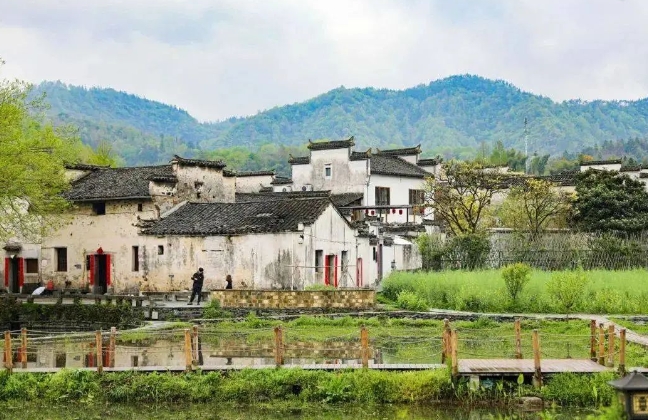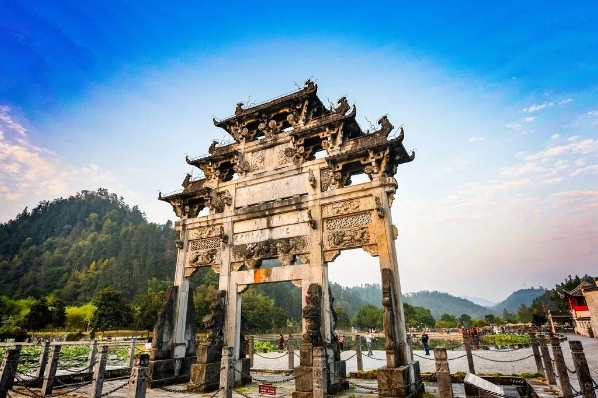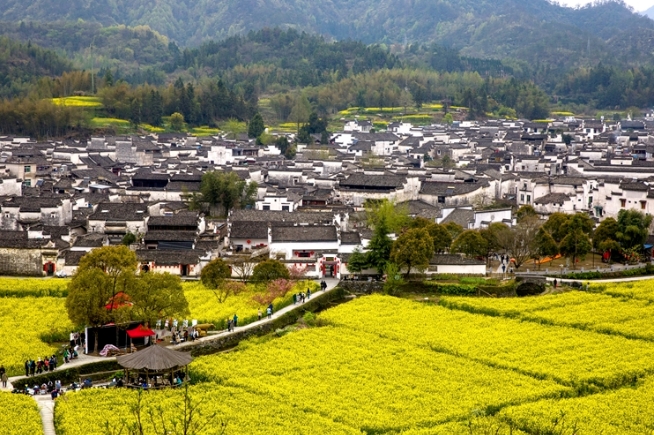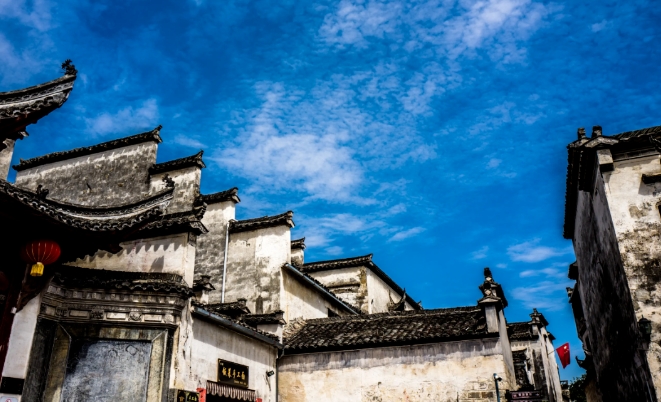
Xidi, originally known as Xixi, was a relay station for delivering letters in ancient times, which is how it got its name. This ancient village is located at the southern foot of Mount Huangshan, surrounded by beautiful mountains. It is a national 5A scenic area and a UNESCO World Heritage site, often referred to as the “Peach Blossom Source.”
As you approach the village, the first sight is a towering stone archway made of blue stone, over ten meters high. Its impressive structure and exquisite carvings make it a landmark of Xidi. Built by the notable figure Hu Wenguang during the Ming Dynasty, this archway symbolizes the village’s virtues of “courage,” “righteousness,” and “morality.” Constructed from locally sourced Qian County blue marble, the archway features intricate carvings with distinct Hui-style characteristics, showcasing superb craftsmanship that has endured over 400 years.
Passing through the stone archway leads you into the heart of Xidi. There are many legends about the village’s name; one popular theory suggests that it was named after a river that flows westward, later changing to Xidi as it became a relay station. The prosperity of Xidi is closely tied to the Hu family. According to legend, the ancestors of the Hu family originally had the surname Li and were descendants of Emperor Zhaozong of the Tang Dynasty. After the fall of the Tang Dynasty, they fled here, and through generations of thriving, a clan village was formed. The Hu family was not only known for its literary heritage but also for its commercial success, leading to several expansions of the village, which eventually became renowned.
From a distance, Xidi emerges in a misty beauty, with ancient buildings arranged harmoniously among rolling hills, their white walls and dark tiles exuding a timeless elegance. The winding alleys create a maze-like atmosphere, seeming to stretch endlessly. The stone-paved paths are dotted among the uniform Hui-style architecture, while clear streams add a lively spirit to this ancient village, justifying its reputation as the “Peach Blossom Source.”
Due to its historical connections to nobility, Xidi has always maintained a strong aristocratic atmosphere. Every brick, wood, door, and window is meticulously crafted. The weathered doors, finely carved window screens, and the curved eaves of the horse-riding buildings all reflect the rich cultural heritage of ancient Huizhou. Among the notable local carvings are the “Three Carvings,” characterized by the style of the Xin’an Painting School, with the “Peach Blossom Source” and “West Stream Farming and Weaving” being the most famous. The intricate carving techniques and layered artistry create lifelike images that are truly impressive. Additionally, the “Pine and Stone” and “Bamboo and Plum” windows in the West Garden showcase exceptional carving skills, vividly depicting these elements, highlighting their elegant characteristics.
The residential architecture is another hallmark of Xidi. The houses are intricately structured, uniquely arranged, and beautifully decorated, perfectly embodying the village’s rich cultural heritage and distinctive local customs, representing a classic example of Hui-style residences. Notable examples include Taoli Garden and Ren Tang.
Taoli Garden is the former residence of the merchant Hu Yuanxi and a private school, built in the late Qing Dynasty. Named after the three characters “Taoli Garden” carved above its entrance, which symbolize abundant peach and plum harvests, the courtyard consists of a typical three-entry, two-story layout divided into the main house and courtyard. Uniquely, it features a “well on the upper floor,” resembling a skylight that allows sunlight to stream in and serves as a viewpoint, showcasing remarkable ingenuity. Ren Tang is where the ancestors of the Hu family once lived. Its exquisite construction radiates cultural charm, with the various antique furnishings exuding a rich historical aura, making you feel as if you are immersed in a long river of time. Here, you will find the creatively designed “Linked Pearl Room,” along with vibrant carvings and meaningful plaques and couplets. The plaque inscribed with “Chrysanthemum Elder” by the famous calligrapher Wang Chengxu from the Qing Dynasty and the couplets emphasizing the importance of education and thriftiness serve as poignant messages for future generations.
In Xidi, the ancient archway stands tall, while the scattered residences bear the marks of time, giving the entire village a tranquil and serene atmosphere. If Mount Huangshan nearby is like a powerful warrior on the battlefield, then Xidi, nestled at its foot, is akin to an ancient hermit in the valley, detached from worldly affairs, seeking inner peace.
Travel Tips
- Location: Yixian County, Huangshan City, Anhui Province
- Best Seasons: March to May, September to November
- Opening Hours: 07:30 – 18:00
- Recommended Route: Zuo Ma Lou – Hu Wenguang Archway – Ying Tianqi Art Museum – Kuang Gu Zhai – Du Yi Ting – Di Ji Tang – Shang De Tang – East Garden – West Garden
- Local Specialties: Stone dumplings, Huizhou dumplings, steamed dumplings, bamboo dumplings, Huizhou steamed buns.